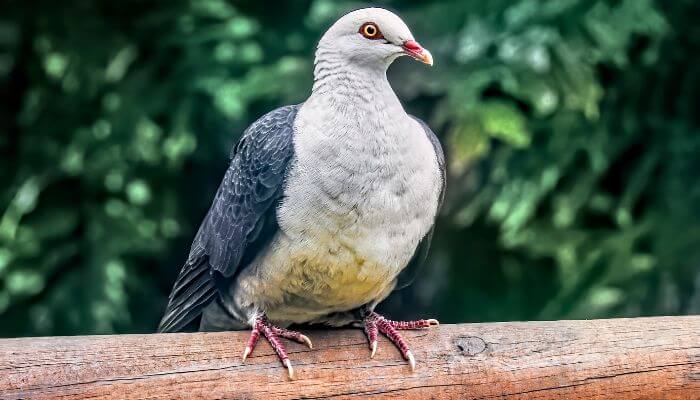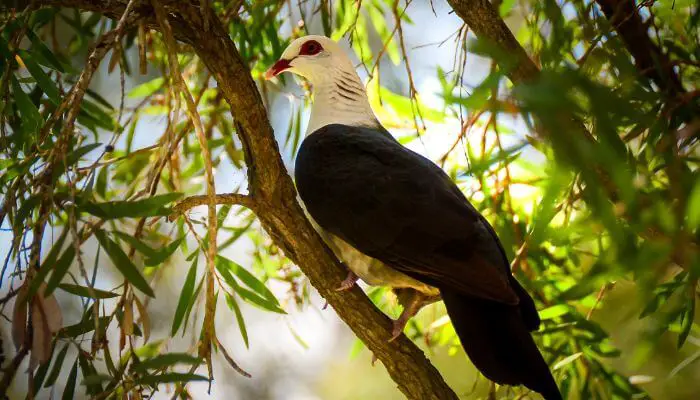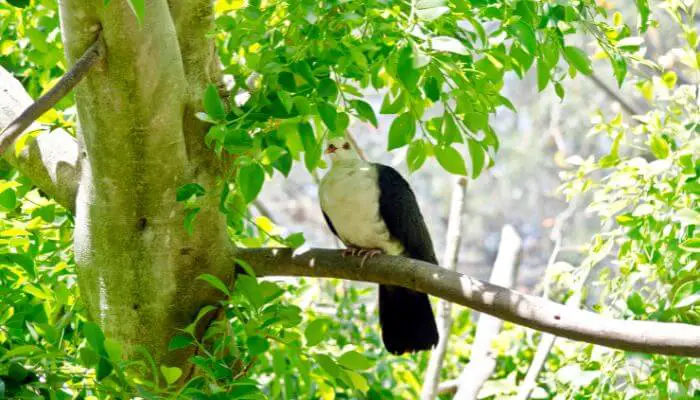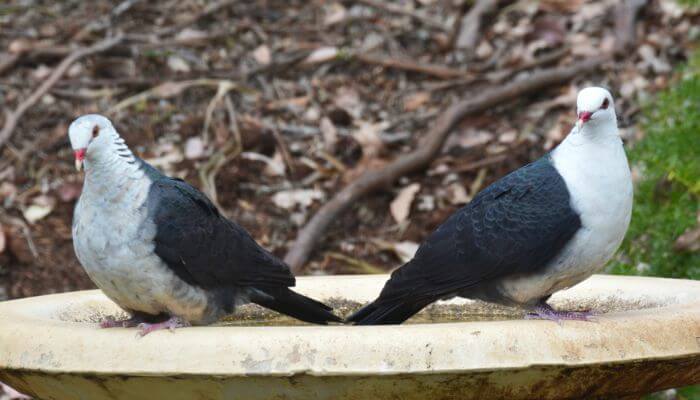The white-headed pigeon, Columba leucomela, is a large species of pigeon native to Australia.
It is a bird that is known for its distinctive white head, which marks a huge contrast to the darker grey body and wings.
Origins of the White-Headed Pigeon
The species naturally developed to take its place among the native Australian pigeons and has been present for thousands of years.
It is considered to be part of the country’s natural biodiversity.
Originally, the description of the white-headed pigeon was confused with a pigeon native to Norfolk Island, the Pacific emerald dove.
When it received it correct binomial classification from Coenraad Jacob Temminck in 1821, it was decided its closest relative is the metallic pigeon, a species no longer found in Australia.
Vernacularly, it is known as the baldy pigeon.

Distribution And Habitat of the White-Headed Pigeon
The white-headed pigeon is endemic to the eastern coast of Australia. It exists east of the Great Dividing Range from Cooktown in far north Queensland to the Illawarra district of southern New South Wales.
They are most abundant in coastal districts preferring a habitat of rainforest – lowland in the south and higher rainforest in the north.
Within these forest environments, the white-headed pigeon likes to inhabit areas that are covered with tall trees and dense canopies that are usually found along riverbanks. They can also be found in mangrove forests.
They are occasionally seen in urban gardens, parks with wooded areas and sometimes at roadsides.
The white-headed pigeon is considered to be a quite sedentary species, with the populations remaining in specific areas across the year. They will, however, undertake small local migrations to search for food and water when their environment forces them to.
White-Headed Pigeon Status
The white-headed pigeon is currently listed as being of ‘Least Concern’ by the International Union for Conservation of Nature (IUCN).
At the last IUCN assessment in 2016, an increasing population was recorded, particularly in the southern range of its distribution.

Appearance of the White-Headed Pigeon
| Wingspan | Length | Weight | Coloring | |
|---|---|---|---|---|
| White-Headed Pigeon | 70 – 80 cm | 38 – 42 cm | 400 – 470 g | White head, neck, breast, and belly. The body is grey-black. |
| Average Feral Pigeon | 64 – 72 cm | 32 – 37 cm | 300 – 500 g | Bluish grey with some black |
The white-headed pigeon is a large species that has a dark grey body and wings and a broad, white-tipped tail.
The male body has iridescent feathers with a metallic purple or green sheen.
Its most distinctive feature is its white head, neck and breast which marks a sharp contrast to the rest of its body.
The neck and breast area sometimes have a greyish or pale orange tinge to the white.
The species has a black band around the nape that separates the white of the head from the grey of the rest of the body, and its eyes are bright red with legs and feet that are more pinkish.
The female’s white parts tend to be more greyish than white and young birds resemble females more than males.
Character
The white-headed pigeon is locally nomadic, and it can be typically found in pairs or groups of 15 plus.
When out of the forest, the white-headed pigeon is a low-altitude, high-speed flyer.
They follow a straight flight path but if they spot a predator or obstacle will swerve upwards and fly wildly and swiftly away with a furious beating of wings.
White-headed pigeons are among the most secretive and wariest of Australia’s pigeons. Unlike most species that let out a warning call and take flight immediately on sensing danger, the white-headed pigeon will sit silently and motionless in dense foliage either on the forest floor or in a tree to avoid detection.
If it takes flight in response to a threat it will hurtle away with loud claps of its wings.
The dense softer plumage of the adult bird contains powdery down which is used for preening but the white-headed pigeon is known to “throw” the down, particularly from the tail feathers, if it is attacked.
This bird has a couple of distinct vocalisations.
Their main call is a drawn-out series of low-pitched coos used for various communications.
In breeding season, the call becomes a deeper, quavering coo-coo.
Mike FitzGerald
Upper Horseshoe Creek, Kyogle Council, New South Wales, Australia
2020-10-30

Diet of the White-Headed Pigeon
This is a frugivorous species and its favorite roost and food is the camphor laurel tree – an invasive species that was introduced to Australia by Europeans.
White-headed pigeons will live on the flowers, leaves, buds and ripe and unripe fruits of the camphor tree all year round.
They will feed in the canopies in groups of up to 100 birds.
In pairs or smaller groups they will forage on the ground for seeds, grasses and grains if camphor produce is not available. Other than camphor, they’re partial to figs, lilly-pillies and fallen seeds in cornfields.
White-Headed Pigeon Mating And Breeding
Breeding season for the white-headed pigeon is between July and March and the species forms monogamous pairs.
In courtship, the male bird will perform a spectacular, undulating flight above the forest canopy.
He will then land near to a female on a branch to give a display of bowing. He holds his body erect, inflates his throat and breast and then depresses his beak to the breast while inclining his body forward.
He’ll bow to an angle of 25 degrees from horizontal and at its lowest point emits a soft deep coo before returning to the upright position.
He’ll bow several times before he stretches his neck, holds his head high and rapidly opens and closes his beak rapidly a few times.
This display is quite different to other pigeon species’ mating behaviors.
Once paired up, they will build a small platform nest of twigs and vines at anything from 3 to 20 meters off the ground.
One or two small ellipsoidal creamy-colored eggs are laid.
Eggs are incubated for up to 20 days and when hatched, the chicks are fed crop milk by both parents.
The chicks fledge after 20-25 days. They leave their parents but usually stay with the flock.
Two or three broods may be produced each season.

Taking Care Of The White-Headed Pigeon
The best thing that can be done in terms of caring for this wild species is to respect and protect the environments that make their natural habitats.
If the rainforests of eastern Australia thrive, so will the white-headed pigeon.
